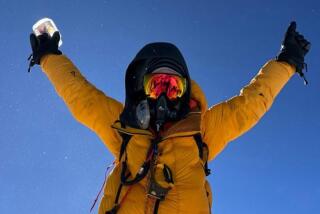Step Up Training for Himalayan Trekking Trip
Folks planning October and November treks in the Himalayas--prime fall months for such adventure--should be getting in shape now. Only those who are physically fit will be able to fully enjoy the spectacular scenery and sense of being in another world.
The sport is popular. Last year, 300,000 people visited Nepal and 50,000 to 60,000 went trekking.
Beware of tour companies that say it is possible to trek and enjoy it without preparation. Trekking 6 to 12 miles a day in thin air at 10,000 feet and higher is physically difficult. Most commercial trekking companies and organizations such as the Sierra Club strongly advise clients about the importance of being in good physical condition, but they admit that a sizable percentage do not heed the advice.
“Those who are not prepared find the initial stages of a trek very unpleasant and difficult,” said John DeCock, director of the Sierra Club’s outing department. “People who are in marginal condition will catch up in five or six days because they have to, but the inadequately conditioned will have a miserable time.”
In addition to altitude, the chief difference between hiking in the Sierra Nevadas and in such places as Nepal and Bhutan is that trails in the Himalayas are much steeper--like a staircase in the higher regions--because they have no switchbacks, according to David Horsely, a Sierra Club trek leader.
In Nepal, some trekkers go it alone with packs on their backs. Others sign up with one of the many organizations in the United States that offer full-service trips which include transportation, visa, permits, camping gear, food, cooks and porters. In Bhutan, trekkers must be part of organized tours.
For first-time visitors especially, trekking solo can be more strenuous than enjoyable. But even those traveling with organized groups need preparation.
“We’ve had people go who have never slept in a sleeping bag before,” said Jim Sano, general manager of InnerAsia Expeditions, a San Francisco-based company that organizes treks to the Himalayas.
InnerAsia recommends training with regular aerobic exercise, during which the heart beat raises to target rate (this varies with the individual according to age and fitness and should be determined by a physician) and stays there for 20 to 30 minutes. Do this four to six times a week and supplement it with stair climbing. Take frequent weekend hikes in steep hilly countryside. Closer to departure time, increase the hiking and add a light day-pack filled with a camera, water bottle, first-aid kit and sweater. Hike in the shoes to be worn on the trek.
Aerobic exercises that strengthen the thighs, then, as well as the cardiovascular system, are the best preparation. Stair climbing and descending are excellent because they mimic trekking. The Sierra Club also recommends running or walking in hilly country and swimming, for its cardiovascular benefit.
Commercial companies and the Sierra Club say the average age of their trekkers is 40, but that travelers in their 60s and 70s are not uncommon. Regardless of age, everybody’s biggest complaint is with their knees, especially on down slopes. Colds, blisters and stomach upsets are the most common health problems. In fact, many trekkers are affected by diarrhea, sometimes from the change in food but more often from contaminated water.
On the road, the Sierra Club recommends boiling all water and making sure of its purity by adding four to five drops of iodine per liter and allowing it to sit for 45 minutes before drinking. They recommend taking at least two one-liter plastic water bottles (take more if additional weight is not a problem), which are available in camping supply stores.
Maintaining adequate water intake--at least four to five liters a day--is essential both for avoiding the effects of dehydration and the effects of altitude.
Altitude sickness is one of the most serious potential health problems for trekkers. Early symptoms include headache, nausea, loss of appetite and mild shortness of breath.
Doctors advise trekkers who develop a headache to immediately stop for the day and take a mild analgesic such as aspirin. This usually allows trekkers to continue the next day if the headache disappears. A headache accompanied by unsteadiness of gait requires descent at once because it could be the earliest sign of a form of high-altitude sickness that can be lethal. Other signs are marked shortness of breath connected with only slight exertion, rapid breathing after rest and wet, congested breathing.
The best preventive, although one not available to most people, is to get used to altitude before beginning a trek by exercising in the mountains. Another, perhaps more workable preventive, is to allow time at the beginning of the trek for the body to adjust to a higher altitude. Planning an altitude gain of no more than 2,000 feet each day also can be helpful.
Prepare for cold weather by taking long pants, as well as shorts, long underwear, a sweater, down jacket, rain slicker and a sleeping bag capable of maintaining warmth at zero degrees. Snow is a possibility.
A typical day with a group trip begins at 7 a.m. with a light breakfast, followed by three hours of hiking before lunch, two hours on the trail in the afternoon, dinner and bed by 9:30 p.m. for a sound sleep on top of the world.
Group travelers will be informed in advance of vaccination and entry requirements to the countries, but others can obtain the information from the country’s embassy in Washington.
Recommended books for people planning a trek include “Trekking in Nepal, West Tibet and Bhutan” by Hugh Swift (Sierra Club Books, $14.95), and “A Guide to Trekking in Nepal” by Stephen Bezruchka, M.D. (The Mountaineers, Seattle, $16.95).
“The right attitude--being positive about one’s self and the experience you are having--is essential, especially for those who are not in top shape,” said the Sierra Club’s Horsely.
More to Read
Sign up for The Wild
We’ll help you find the best places to hike, bike and run, as well as the perfect silent spots for meditation and yoga.
You may occasionally receive promotional content from the Los Angeles Times.






